Targeting new customers on social media makes a lot of sense due to the amount of time people spend online. Facebook is the largest social media platform and so its PPC ads attract a lot of attention. But, there’s a wealth of other sites which feature in people’s lives on a daily basis. It’s just making the jump between your business and their browsing time.
Let’s look at PPC ads on different social media sites and what they can offer you.
Snapchat ads
What are Snapchat ads?
Snapchat is a photo-based messaging app that is popular among younger demographics. Its ad platform boasts the ability to allow advertisers to “reach a global audience and become a part of their everyday conversations”.
Why use Snapchat ads?
Snapchat has nestled itself in a nice little niche: organic content. Snapchat is the raw side of social media where you don’t have to spend hours curating your posts for popularity. It’s the home of quick snaps that show a more natural, human side to social media users. The nature of the platform has proven successful for SMBs (small-to-medium businesses) who want to engage with a younger audience. So, if this is your target demographic, Snapchat ads may hold the key to your success.
Snapchat has some impressive stats on its audience size too. Whilst those who use it live within a certain age bracket, it still offers huge variety.
- Snapchat has 191 million active daily users
- They spend an average of 30 minutes a day on the app
- 78% of 18-24-year-olds use it regularly which is 7% more than Instagram
- Snapchat also has more users than Twitter
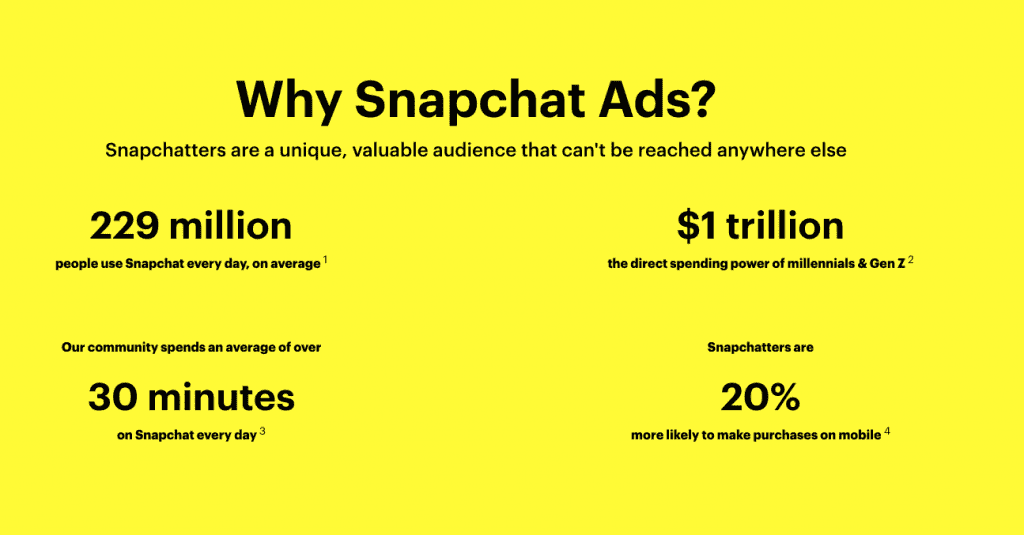
Snapchat also offers a wide range of audience targeting so you can really spend the time narrowing down the field if you have the expertise. Its audience targeting has the same sophistication as the likes of Facebook with lookalike audiences allowing you to pinpoint your ideal types of customer.
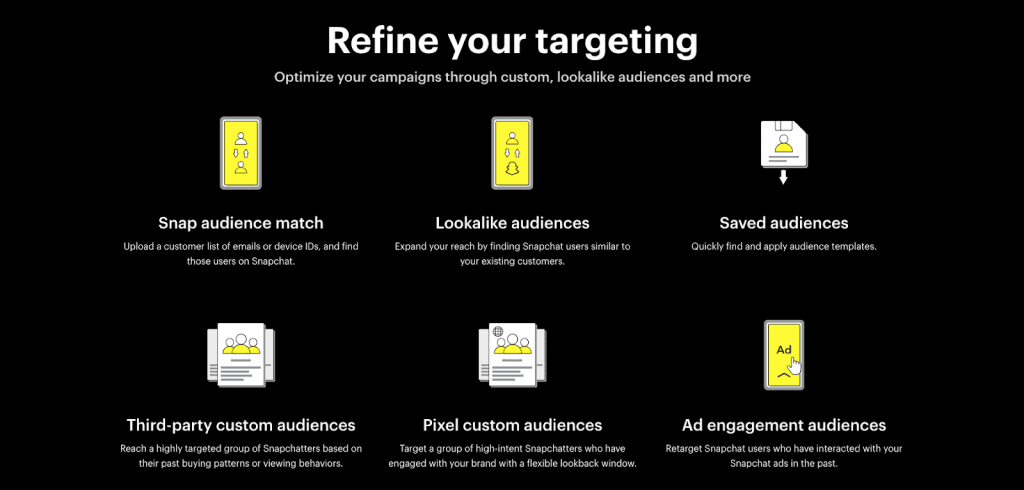
The benefits of Snapchat ads
Snapchat has a strong built-in video creation tool, so you don’t need to go anywhere else to create your ads. This alone is a brilliant feature as it allows sleek videos to be produced by pretty much anyone. However, this does open video advertising up to more people so there may be more competition than you expect.
Different types of Snapchat ads
Snap ads
Snap ads are full-screen video ads that play with sound on. There are different ones depending on your goal.
Web views
- Display: full-screen video ad between 3-10 seconds
- Goal: to get users to swipe up and check out a website/fill in a form
- Benefit: embedded lead capture forms are proven to work well
Mobile app installs
- Display: short video with an ‘install now’ CTA
- Goal: to get users to swipe up to install an app
- Benefit: you don’t have to leave Snapchat to download the app creating a seamless experience
Long-form video
- Display: short teaser video which leads to longer version
- Goal: to get users to watch full trailer/how-to video
- Benefit: tempts people to watch the video by showing a clip

Filters and lenses
These are two advertising options on Snapchat but I’ve chosen to group them together as they serve the same goal – brand awareness.
Lenses are augmented reality animations which users can play with when they take a photo. Think: dog filter, granny filter, heart-eyes filter. You’ll have seen them on most teenage girls’ social media profiles for years now. Now Snapchat has made it possible for brands to create their own.
Filters are basically lenses but static versions, so you don’t need any fancy tech work involved. They’re best when they’re arty rather than photo-realistic, which means you’ll want to get your design team involved. If you don’t have one, they’re a lot of effort and can be a little dull, so save it for when you have a really great idea.
Personally, I have reservations about both of these. Unless you’re a large brand, this type of advertising can be a little gimmicky. These are ideal supplements for if you’re holding an event or have a physical store. You could run a competition which encourages people to take photos with the filter and put them on social media. Otherwise, someone sending a Snapchat to their Nan with your logo on it isn’t going to see your sales soar.
Twitter ads
Why advertise on Twitter?
Twitter’s USP is its real-time commentary on what’s going on in the world. If something is happening, it’s Twitter that people gravitate towards. It’s a global conversation with millions of voices. Advertising in this space offers a way to insert yourself into industry topics and connect with relevant people.
Twitter has 330 million monthly active users and sees more than 500 million tweets a day. From a marketing perspective, 40% of users bought something after seeing it on Twitter.
Many brands have a Twitter account to engage with their customers in a casual way. It’s great for updates, blog posts, announcements and asking for opinions. Putting a poll out to help you decide between two new product choices helps your customers feel involved and offers insights which you may not have found from your usual ideation sessions.
Twitter offers a conversational approach to engaging with existing and new customers, so if you’re already seeing success on the platform, its ads might help take things to the next level.
How Twitter ads work
Advertising on Twitter is split into two parts: Promote Mode and Twitter Ads.
If you’re looking for a quick way to gain attention, you can promote an ad to get it seen by more people; promoted tweets appear on the timelines of and in the search results of specific users.
Twitter Ads is a more all-encompassing approach that uses multiple angles to work towards the same objective – the traditional PPC campaign you’d expect.
Promoted Tweets
Promoted tweets are an option within Twitter ads.
Put simply, your ‘ad’ is your tweet and you can customise the audience of who sees it based on interests or location. Currently, you can only promote tweets in the UK, USA and Japan.
The key things to know are:
- Promoted tweets run on a flat monthly fee of $99
- Promoted tweets increase followers 10 times more than organic tweets
- Promoted tweets are less likely to be lost in the noise of all the other tweets
- You can also promote your whole Twitter account
Twitter Ads
The wider PPC picture offered by Twitter runs on a pretty traditional PPC model making it easy to get to grips with. If you’re familiar with the Facebook interface, chances are you’ll get on with Twitter Ads.
Like all PPC models, you only pay when your marketing goal is reached. If you want more followers, you only pay once people have followed you. If you want to drive people to your website, you only pay when they land on the page. But, you’ll gain a lot of free impressions even if people don’t click.
This is where Twitter Ads differ from Search – you don’t have to bait someone into clicking for them to take something away. Your brand awareness goal can be achieved without any clicks due to the visual nature of the ad.
However, social media doesn’t see the same intent from its users as Search does, meaning CTRs are generally lower. So, it’s worth devising a separate social strategy when using a platform like Twitter to ensure you’re using its strengths to boost your business, rather than trying to shoehorn your goals best suited for Google into it.

Adzooma recommends
Use Promote Mode to promote existing content
Rather than boosting your whole Twitter account or announcement tweets, you can use it to amplify your blog posts.
Guest blogging has many draws but means you need to create a new piece of content for every site. You can achieve a similar reach through Twitter, but with your existing content – saving hours of time. Attract people with your catchy headlines and intriguing content and make them aware of your brand by offering them value. You need to make people fans of your brand before they become customers. Content has always been a strong way of doing this, so using Twitter is an excellent way to expand your reach.
LinkedIn ads
What are LinkedIn ads?
Ads on LinkedIn come in a variety of formats. They’re best suited to B2B products or services. These are the different options:
Sponsored Content
These in-feed ads are identifiable by the ‘promoted’ tag underneath the company name.
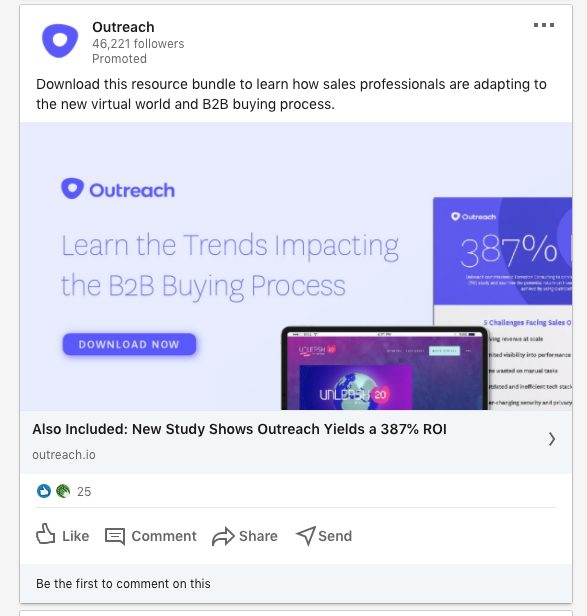
Text ads
These appear at the top of the Linkedin feed or on the right-hand-site and link to a website of the advertiser’s choice.

Sponsored Messaging
These ads fall directly into the inbox of your target audience. They appear like normal conversations but are identifiable by the sponsored tag at the bottom.
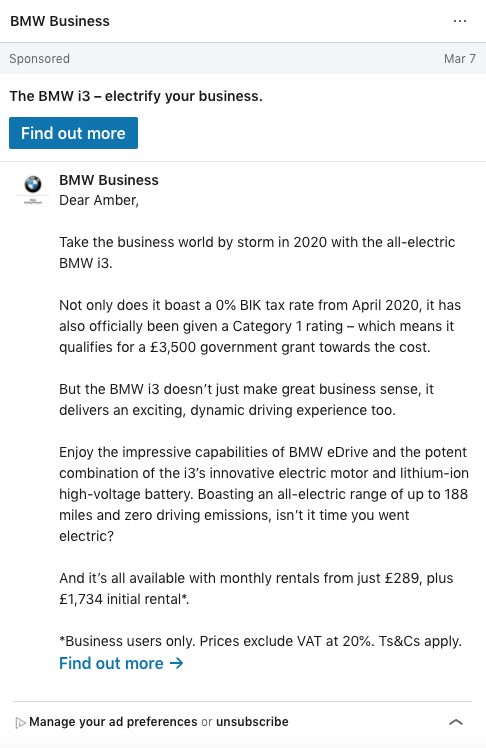
Dynamic ads
These are unique to each user and utilise their profile info and image to personalise them.
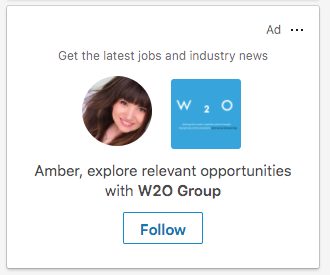
LinkedIn audience network
LinkedIn has a large audience network and your ads can also appear on third-party publisher sites.
Why advertise on LinkedIn?
LinkedIn has 660 million users with 40% of them using it on a daily basis. It’s the most used social media platform amongst the Fortune 500 companies.
LinkedIn differentiates itself from other social media sites by targeting itself at businesses. It’s a social media platform for professionals who are looking to network with other like-minded individuals. They use it to enhance their business, contacts and social stature. Advertising in this space allows you to target business-oriented users – something you won’t find on other social media platforms.
LinkedIn’s targeting is highly specific. It allows you to narrow your audience based on their education, degree level, skillset, job, industry, and more. If your business is best suited to a demographic who can be highlighted through these filters, LinkedIn ads will be a strong way for you to get in front of them. The aim of alternative PPC sites is utilising the niches which are made available to you – LinkedIn makes this possible through their user-generated data.
How expensive are LinkedIn ads?
LinkedIn ads aren’t that cheap. However, all that means is you need a strong strategy behind running them – which is what all good PPC ads need anyway.
Its minimum spend cap is $10 per day per campaign. This understandably puts smaller businesses off if they’re unsure of what they’re doing. But it also means there’s more opportunity for those who do stump up the cash as there’s less competition. So, if your ideal customers are other businesses or working professionals, LinkedIn ads could work well for you.
Struggling to decide which one is best for you?
There’s only so many guides you can read and data you can analyse before deciding whether a social media platform can help you bring in new customers. Your business is unique, regardless of how saturated your industry may be – what works for others may not work for you. Similarly, where others have failed, you may succeed.
If you’re unsure whether Snapchat, Twitter, LinkedIn or any other type of ads will bring you results, trial it. Start small, with a fixed budget, and see what the return is like. A lot of social media sites have automated options which can get your ads set up in no time. Better yet, you can simply reproduce your PPC ads from other sites to start with, and then customise them once you get some results.
You don’t know what’s out there until you try.




